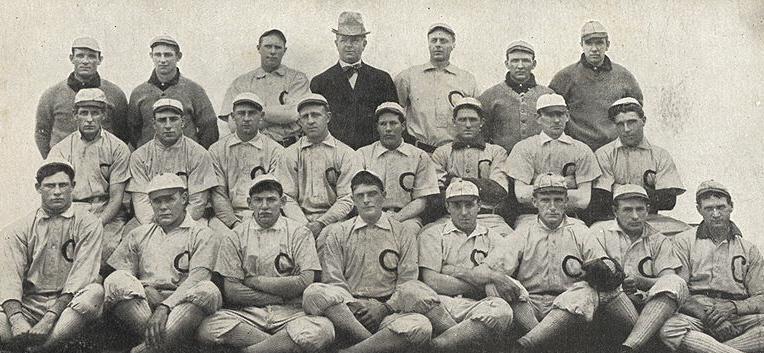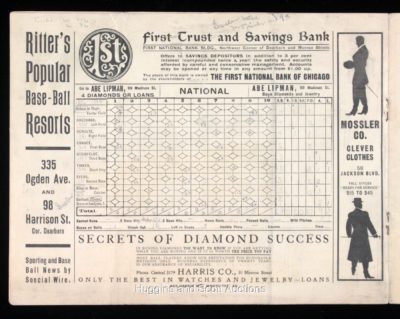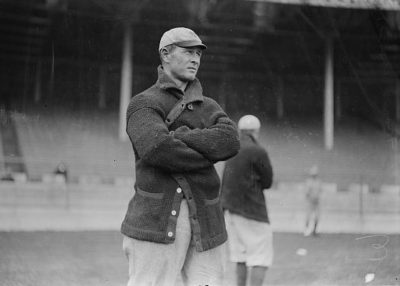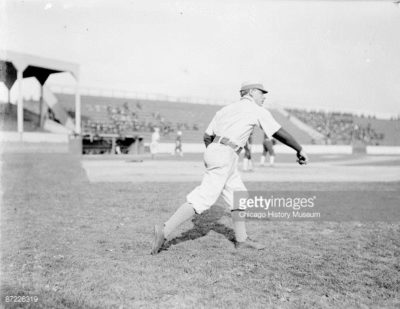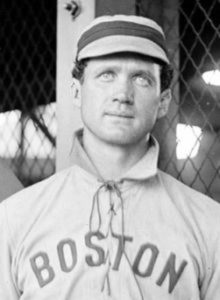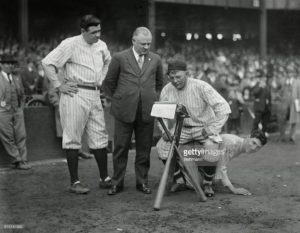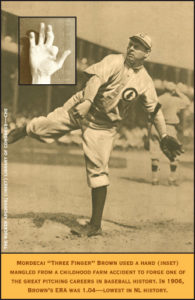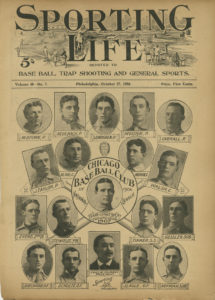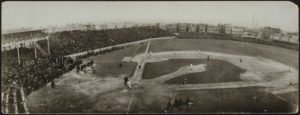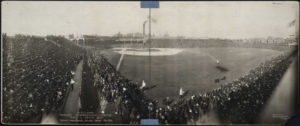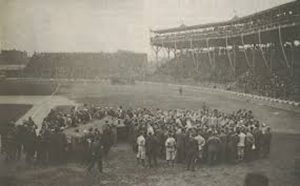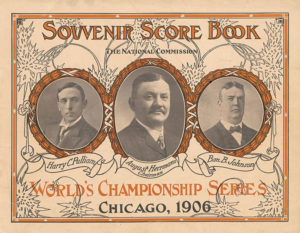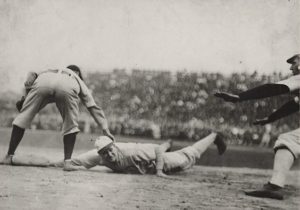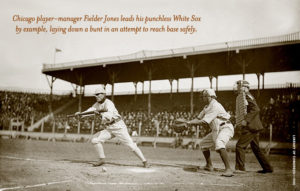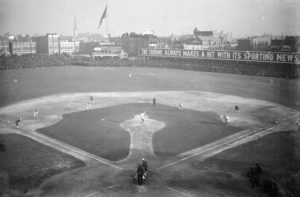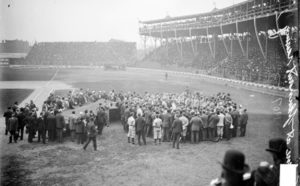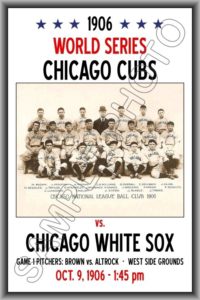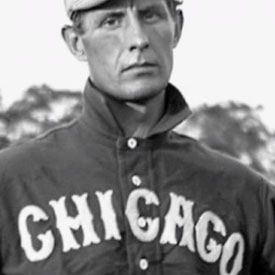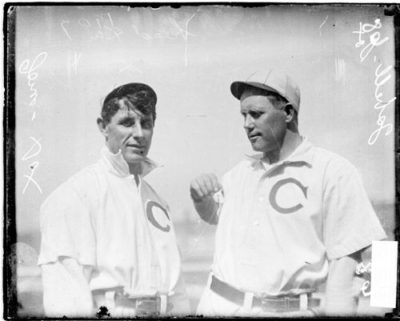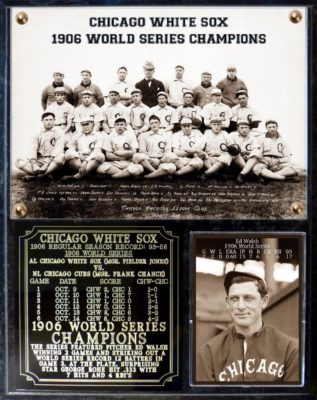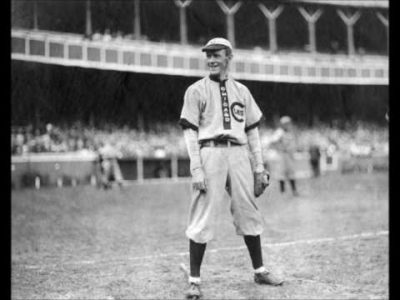Featured Panoramic Photo Above:
Classic Charles Conlon photo of Ty Cobb sliding into Jimmy Austin
Baseball History Comes Alive Now Ranked As a Top Five Website by Feedspot Among All Baseball History Websites and Blogs!
(Check out Feedspot's list of the Top 35 Baseball History websites and blogs)

Guest Submissions from Our Readers Always Welcome! Click for details
Subscribe to Baseball History Comes Alive! for automatic updates (sign-up block found in right side-bar)
As a Free Bonus for subscribing, you’ll get instant access to my two Special Reports: Memorable World Series Moments and Gary’s Handy Dandy World Series Reference Guide!
1906 “Hitless Wonders” White Sox Photo Gallery
Click on any image below to see photos in full size and to start Photo Gallery:
The Dead Ball Era is my favorite period in baseball history. That’s when “small ball” was in style and the game was played in its purest form. I also enjoy going through the Dead Ball Era looking for interesting tidbits of information that would otherwise be lost over the passage of time. I think I’ve uncovered a real gem today, when the “Hitless Wonders” started on a 19-game winning streak. -GL
Back Into the Dead Ball Era:
The 1906 “Hitless Wonders” Start 19-Game Winning Streak!
One hundred fourteen years ago this week, the 1906 White Sox, known as the “Hitless Wonders,” began a 19-game winning streak. It started on August 2 in a 3-0 victory over the Boston Americans, and ended on August 25 in a 5-4 loss to the Senators. The winning streak was the longest in the American League for the next 96 years, until finally broken by the Oakland Athletics’ 20-game streak in 2002.
When the streak started, the Sox had been in fourth place, seven-and-a-half games behind the defending American League champion Philadelphia Athletics. By the time it ended, they had been propelled into first place, and they stayed there on their way to the American League pennant.
The White Sox (93-58) finished three games ahead of the New York Highlanders, in spite of having the league’s worst batting average (.230). What they lacked in offense they made up for in pitching, which was truly their strength. The team’s four main starters, all at or near their prime, were rock solid. Frank Owen and lefty Nick Altrock were perennial 20-game winners. Doc White was usually good for 15-18 wins with earned run averages below 2.00. The fourth member of the rotation was 25-year-old spitballer Ed Walsh, just entering into his Hall-of-Fame career. With the White Sox’ anemic offense, the starters knew they had to be nearly flawless. They came through splendidly, with 117 complete games, a league-leading 32 shutouts, and a 2.13 ERA that was the second-lowest in the league.
To compensate for the poor offense, the White Sox, managed by Fielder Jones, took the term “small ball” to new heights. They were adept at taking walks, “taking one for the team” to get on base, and bunting runners around with sacrifices. They led the league in all three categories. Their ability to “manufacture runs” (as we call it today) placed them third in the league in runs scored. Thus was the genesis of a great baseball nickname coined by Chicago sportswriters: “The Hitless Wonders.”
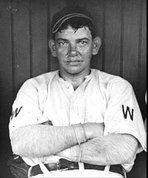
(In the featured photo above, we see the 1906 pennant-winning “Hitless Wonders.” Player identifications at bottom of post)
Only three regulars managed to hit over .250: Second baseman Frank Isbell led the team at .279, followed by veteran switch-hitting shortstop George Davis at .277, and first baseman Jiggs Donahue at .257. Player-manager Fielder Jones matched the dismal team average of .230. Third baseman Lee Tannehill hit .183. Catcher Billy Sullivan was at .214. Most of the bench players hit well below .200. Even two early-season additions who had hit well in the past tailed off dramatically: Eddie Hahn, a .319 rookie hitter with the Highlanders in 1905, and Patsy Dougherty, a career .301 hitter. Both came hit a paltry .230 for the year.
And power numbers? Well…there just wasn’t much. They hit a grand total of seven home runs for the entire year, an embarrassing total even by Dead Ball Era standards. Jones and Sullivan were the Sox’ top sluggers with two homers each.
And who should the White Sox draw as their opponents in the 1906 World Series? None other than the powerful, heavily-favored Cubs with their dominant hitting, slugging, fielding and incredible pitching that led to 116 wins, 36 losses, and an all-time best .763 winning percentage. But as is well known, the “Hitless Wonders” prevailed, proving true the baseball adage that you can’t win without good pitching, but adding to it by proving you could win without good hitting.
1906 White Sox:
Top Row, L-R: Ed McFarland, James Hart, Frank Isbell, Charles Comiskey, Lou Fiene, Billy Sullivan, Doc White. Middle Row, L-R: Fielder Jones, Frank Smith, Lee Tannehill, Frank Roth, Ed Hahn, Gus Dundon, John Donahue, John O-Neill. Front Row, L-R: Ed Walsh, Jay Towne, Nick Altrock, Frank Owen, George Davis, George Rohe, Ray Patterson, Patsy Dougherty
-Gary Livacari
Photo Credits: All from Google search
Information: Excerpts edited from article: “The Hitless Wonders,” found on the On-line Book of Baseball.http://www.thisgreatgame.com/1906-baseball-history.html
Check out my latest book, recently nominated for the SABR 2020 Lawrence Ritter award: Reflections On the 1919 Black Sox: Time to Take Another Look now available on Amazon in e-book and paperback. All profits go to the Illinois Veterans Foundation
Add your name to the petition to help get Gil Hodges elected to the Hall of Fame
Vote In Our New Poll: How Do You Feel About the 60-Game Proposal for the 2020 Season?
We are a participant in the Amazon Services LLC Associates Program, an affiliate advertising program designed to provide a means for us to earn fees by linking to Amazon.com and affiliated sites. Click here to view Amazon’s privacy policy

